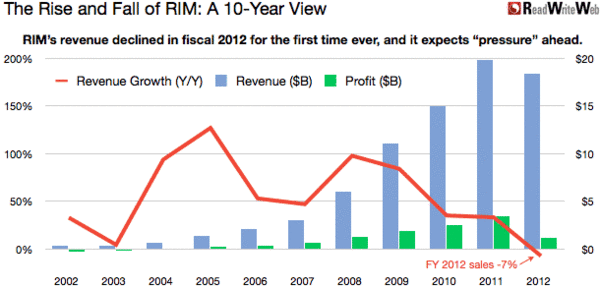
Let’s be real: Anyone who’s been paying attention isn’t surprised by BlackBerry maker Research In Motion’s recent collapse. It’s unfortunate, but it’s been inevitable.
On Thursday, RIM announced its latest bad news: Last quarter’s sales and losses were worse than expected, and its new BlackBerry 10 platform won’t be ready until next year. (Too late.) RIM shares fell some 14% in after-hours trading; they’re down about 95% since mid-2008. And the company will now have to cut some 5,000 jobs, which is sad to hear.
How the iPhone Changed Everything
What happened? Nothing recently. Rather, RIM’s fate started tumbling five years ago Friday: June 29, 2007, the day Apple first started selling the iPhone.
It’s hard to overstate just how much Apple’s entry into the phone market changed things. Apple didn’t invent the smartphone, but it took mobile devices to a new level with the iPhone’s all-screen layout, revolutionary software, touch-based interface and its near-perfect integration.
RIM and its contemporaries saw “smartphones” mostly as phones, with some email and basic web stuff crammed in. But Apple saw the iPhone as a tiny portable computer, capable of running the same powerful operating system and Web browser that a laptop could. So the day the iPhone came out, everyone else was immediately playing catch-up.
How RIM Kept On Going
It was soon obvious – especially after Apple launched the iPhone App Store in the summer of 2008 – that RIM and the BlackBerry were in trouble, completely overpowered by the iPhone. But RIM had a few things going for itself: Huge support from big enterprise customers, which initially laughed at the iPhone; a small customer base to start from, which allowed it to put up big growth numbers relatively easily; a recent entry into the consumer market, which fueled most of its growth after the iPhone launched; a solid email product and plastic keyboards, which early fans loved; and new growth in foreign markets after starting small in North America.
So for years, RIM kept growing and was still profitable, and whenever questions about the iPhone came up, RIM blasted them away with hot air. BlackBerry traveled through Europe, Latin America and the mid- and low-end markets, and was able to show profitable growth. RIM’s first touchscreen BlackBerry, the Storm, was a joke. But it sold well, because its U.S. carrier Verizon Wireless needed something, anything to compete with the iPhone in the pre-Droid days, so it promoted the heck out of it, and RIM benefited.
But RIM was a ticking time bomb: Even though it put up decent numbers sometimes and talked a lot, it wasn’t showing a real plan for the future or phones that could legitimately compete with the iPhone.
When I wrote in 2010 that RIM was the “new Palm,” I wasn’t far off: “RIM appears to be in a very similar position to where Palm was just a few years ago: A high-flying smartphone incumbent, suddenly looking very vulnerable, very quickly, as new competition shoots past it.” My prognosis: “The risk for RIM is that it will increasingly lose the high end of the smartphone market to Apple and Google, and be forced to become a lower-margin, low-end player. And that’s not what RIM investors have in mind for the company.”
Indeed, things started happening. Enterprises let employees use their own iPhones for work email; Android ate away at the low end of the market; the iPad arrived; and Apple supported more carriers around the world. For RIM, which still hadn’t caught up, taking the lead became impossible.

Now What?
The good news is that RIM still has almost 80 million subscribers, is still selling some phones, still has some big customers (governments, huge companies, etc.), and still has some useful technology for back-end services. In theory, that should be worth something to someone – Microsoft, Cisco, Apple, Oracle, Salesforce.com, Facebook, Huawei, Amazon, etc. The bad news is that the price tag for RIM has been shrinking rapidly. As its technology continues to decay, why pay more than you need to?
When I first argued in early 2009 that Microsoft should buy RIM and make its big mobile bet, I wrote that it would have probably cost $35 billion to get a deal done. Today, RIM is worth less than $5 billion; it shouldn’t take much more than that to bid. (Meanwhile, Microsoft has since realized that it needs to go into the hardware business to make money in mobile.) But what’s there? The cost of cleaning up the mess will be high, and the value of what’s left is low. Three years ago, there might have been a chance to salvage something useful. Today, the scraps are scraps.
In today’s patent-crazy mobile world, it wouldn’t be a shock – especially if RIM’s stock continues to fall – to see a bid by the end of the year. But a sale now won’t be a congratulatory event for RIM. It will simply be the end of a once-strong company that got outmatched and couldn’t come back.









